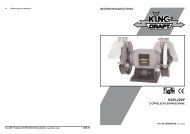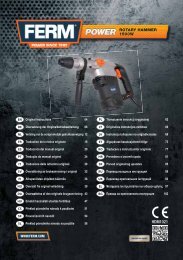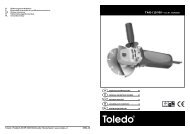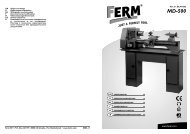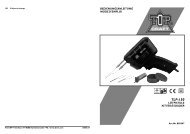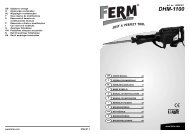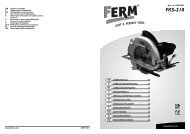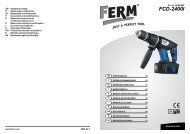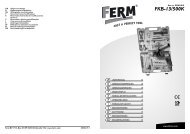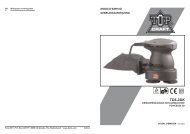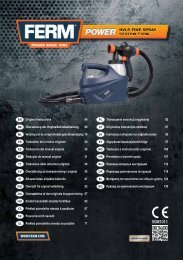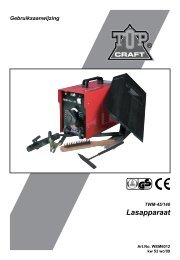Ma 1209-18.1.pdf - Firma Servotool GmbH
Ma 1209-18.1.pdf - Firma Servotool GmbH
Ma 1209-18.1.pdf - Firma Servotool GmbH
Create successful ePaper yourself
Turn your PDF publications into a flip-book with our unique Google optimized e-Paper software.
EN<br />
• Start the machine by pressing the “lock off”<br />
button (to disengage the switch) and switch on<br />
the machine.<br />
• The planer is now switched on and you can let<br />
go of the release button.<br />
• Always hold the planer with both hands on the<br />
handles, so as to gain the best possible control<br />
over your planing operations. Besides you do<br />
not risk becoming in touch with the moving parts.<br />
• When the machine has reached full speed it<br />
can be pushed to the front over the work<br />
piece. At the beginning of the planing<br />
operation, put some pressure on the front and<br />
at the end of the operation, on the rear of the<br />
appliance. This results in the appliance<br />
remaining flat on the work piece and prevents<br />
the corners from getting rounded off.<br />
• To obtain a level and smooth surface use a<br />
greater planing depth when rough planing and<br />
a lesser planing depth when planing a layer.<br />
Hold the electric tool straight during the<br />
operation, otherwise you will obtain an uneven<br />
surface. After the operation switch off the<br />
electric tool and remove the mains plug.<br />
Bevelling edges<br />
Fig. 1<br />
The V-groove in the planer shoe allows easy<br />
beveling of workpiece edges. Place the planer<br />
with the V-groove (7) onto the edge of the<br />
workpiece and guide along the edge.<br />
Warning! Use spindle lock only in stand<br />
still mode.<br />
• Take care that your hand never comes in<br />
contact with the work piece during the<br />
operation.<br />
• Only use the electric plane on the upper side<br />
of the work piece, never from below or from<br />
the side.<br />
• Store the appliance only after it has come to a<br />
complete standstill.<br />
• Use a suction device to suck off wood<br />
shavings or dust. For this use the connecting<br />
pipe and connect a suction pipe to it.<br />
• Use a holding device to work on small work<br />
pieces.<br />
Fitting the rip fence<br />
Fig.4<br />
• Loosen knob (9).<br />
• Insert the rip fence into the slots provided.<br />
• Set the correct cut width and tighten the knob<br />
(9).<br />
4. CARE & MAINTENANCE<br />
Before undertaking any care or<br />
maintenance always remove the mains<br />
plug from the socket.<br />
The planing tool becomes worn after a period of<br />
operation. If you use a blunt or damaged planing<br />
tool operational efficiency is reduced and the<br />
electric motor might become overloaded. Check<br />
the planing tool regularly with regard to wear or<br />
damage. Depending on its condition, the planing<br />
tool will have to be replaced.<br />
Removal of plane blade<br />
Fig. 3<br />
Use the enclosed open-jawed spanner<br />
(Accessories). First unscrew the three clamping<br />
screws (6) with the open-jawed spanner and<br />
remove the plane blade (3), the plane blade holder<br />
(2) and the plane blade support (4) from the<br />
holding shaft (1).<br />
Installation of plane blade<br />
Fig. 3<br />
Take the new plane blade (3) and position it<br />
between the plane blade support (4) and the plane<br />
blade holder (2). Now turn the clamping screws (6)<br />
as far as possible into the plane blade support. But<br />
not so far that the plane blade and the plane blade<br />
holder become detached again from the plane<br />
blade support. Afterwards put the plane blade,<br />
plane blade holder and plane blade support<br />
together into the holding shaft. The plane blade<br />
support, plane blade and plane blade holder will<br />
now be fastened together in the holding shaft by<br />
releasing the clamping screws with the openjawed<br />
spanner and thus the plane blade, plane<br />
blade support and plane blade holder are clamped<br />
in position.<br />
Attention! Unscrew clamping screws as fas as<br />
possible so that a sufficient attachment is ensured.<br />
Warning!<br />
• When installing and removing the plane blade,<br />
care has to be taken that all parts (plane<br />
blade, plane blade holder, plane blade support<br />
6 Ferm



